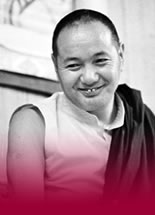Robina’s Blog
18 January, 2024
As we know, the Buddhist view is that everything we think and do and say, just naturally leaves an imprint in our mind, or seeds, as Buddha puts it. And as we all know, seeds bring fruits. This is the natural law of karma, cause and effect.
In other words, whatever we think and do and say is the very process that produces the person we become. As His Holiness the Dalai Lama said one time, “The law of karma is like self-creation.”
So let’s unpack what's involved in this process of creating our own experiences, our own self. In the Tibetan Buddhist monastic university system, they really study in depth the details of this.
We know perfectly well that if we want a garden, we need to learn the natural laws of botany; you can't just cross your fingers or hope that someone else will grow it for you!
We know we’re in charge of getting a good garden, but we do not think we’re in charge of producing ourselves. We’re totally convinced that happiness comes from out there. But I’m the one who brings my own happiness, and I'm the one who causes my own suffering. In other words, we’re in charge. Big surprise!
So I’d better know the details!
Let’s break it down, what’s involved in, let’s say, a virtuous action of not-killing. I use a mouse as an example because people don’t like mice much. In order for an action of non-killing to become a complete action, one that will produce a good rebirth in the future, there are four things in place when you do that action.
The first thing is the object: a mouse in your kitchen.
The second thing is your mind involved in the action of not killing. This is the crucial piece, and there are two bits here, roughly. It’s more complex than this, but this is keeping it simple. First, there would be the intention, bare-bones volition: I will. In this case it will be, “I will not harm that mouse. I will not kill that mouse. I must not kill that mouse.”
The second part of the second point – your mind involved in it – is your motivation, the most important. Here, it's compassion, isn't it? It would be compassion. You could say the motivation, compassion, arises first if that’s your tendency, and then from that comes, “I must not kill the mouse.” These are so close together it's like there's one moment of mind, but there's two bits there. There's the thought, “I will not kill the mouse,” and then there's what motivates it. What motivates it, what is underneath it, what drives that thought: in this case, it is compassion.
It's the same thing when you see a homeless person. One, there’s an object: a person. Two, you think, “Oh, I'll give ten dollars.” What motivates that? Generosity, kindness – it’s obvious – but intention and motivation are so quick together, usually, unless you really struggle with generosity, and you’re wanting to practice generosity.
Your generosity is the motivation for giving. Your compassion is the motivation for not killing. There's always motivation behind whatever we do. If you consciously decide, “I will not give ten dollars, I will not give any money to that ugly homeless person,” what's the motivation? It's obvious: miserliness. “I don’t want to give. Why should I give to that person?” Miserliness is your motivation.
The third component is you do the action: saving the mouse. There’s the object, the mind involved, and then the action of saving the mouse.
Then the fourth component is the result: happy mouse. You release it out the door: “Thank you, Robina. Bye-bye.” Happy mouse. That’s a complete action of non-killing, speaking simply.
A complete action of generosity involves one, a homeless person. Two, your mind involved in it: one, “I will give ten dollars”; why? generosity. Then three, your hand goes in your pocket and you give the ten dollars. Four, the person receives your ten dollars. That’s a complete action of generosity.
These are really rich, delicious, positive karmic actions that pop really delicious, rich karmic seeds into your bank vault, and these are the seeds that continue to produce future good results.
With this complete action, all four results of karma will come: one, a good rebirth, such as a human one; two, a tendency to not kill; three, the experience of not being killed or dying young; and, four, a good environmental result such as good health, nourishing food, pure water and air, etc.
Forget about nirvana or buddhahood, at the very least is this not what we want in the future?
So we’d better sow the seeds right now!

